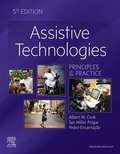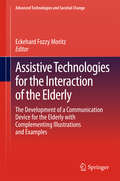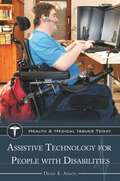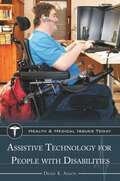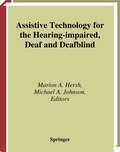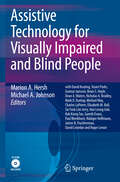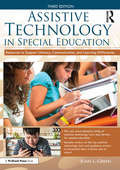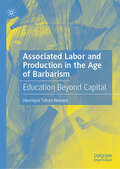- Table View
- List View
Assistive Technologies- E-Book: Principles and Practice
by Albert M. Cook Janice Miller Polgar Pedro EncarnaçãoMaster the assistive strategies you need to make confident clinical decisions and help improve the quality of life for people with disabilities. Based on the Human Activity Assistive Technology (HAAT) model developed by Al Cook, Sue Hussey and Jan Polgar, Assistive Technologies: Principles & Practice, 5th Edition, provides detailed coverage of the broad range of devices, services, and practices that comprise assistive technology. This new text offers a systematic process for ensuring the effective application of assistive technologies — and focuses on the relationship between the human user and the assisted activity within specific contexts. It features over 30 new photos and illustrations, as well as, updated chapters and case studies that reflect current technology.Human Activity Assistive Technology (HAAT) framework locates assistive technology within common, everyday contexts for more relevant application.Focus on clinical application guides application of concepts to real-world situations.Study questions and chapter summaries in each chapter help assessment of understanding and identification of areas where more study is needed.Coverage of changing AT needs throughout the lifespan emphasizes how AT fits into people’s lives and contributes to their full participation in society.Principles and practice of assistive technology provide the foundation for effective reasoning.Ethical issues content provides vital information to guide AT service delivery.Explicit applications of the HAAT model in each of the chapters on specific technologies and more emphasis on the interactions among the elements make content even easier to understand.New! Thoroughly updated chapters to reflect current technology and practice.New! Expanded discussion on assistive robotics and smart technologies.New! Review of global initiatives on Assistive Technology.New! Updated art program with 30+ new photos and illustrations.New! Updated case studies to reflect changes in technology and practice since last edition.
Assistive Technologies for People with Diverse Abilities (Autism and Child Psychopathology Series)
by Giulio E. Lancioni Nirbhay N. SinghThe familiar image of the disabled tends to emphasize their limitations and reduced quality of life. However, many people with cognitive, motor, and other difficulties also have the capacity to enhance their social interactions, leisure pursuits and daily activities with the aid of assistive technology. Assistive devices from the simple to the sophisticated, have become essential to intervention programs for this population. And not surprisingly the numbers of devices available are growing steadily.Assistive Technologies for People with Diverse Abilities offers expert analysis of pertinent issues coupled with practical discussion of solutions for effective support. Its comprehensive literature review describes current and emerging devices and presents evidence-based guidelines for matching promising technologies to individuals. Program outcomes are assessed, as are their potential impact on the future of the field. In addition, chapters provide detailed descriptions of the personal and social needs of the widest range of individuals with congenital and acquired conditions, including: Acquired brain damage.Communication impairment.Attention and learning difficulties (with special focus on college students).Visual impairment and blindness.Autism spectrum disorders.Behavioral and occupational disorders.Alzheimer's disease.Severe, profound and multiple impairments.The scope and depth of coverage makes Assistive Technologies for People with Diverse Abilities an invaluable resource for researchers, professionals and graduate students in developmental psychology, rehabilitation medicine, educational technology, occupational therapy, speech pathology and clinical psychology.
Assistive Technologies for the Interaction of the Elderly: The Development of a Communication Device for the Elderly with Complementing Illustrations and Examples (Advanced Technologies and Societal Change)
by Eckehard Fozzy MoritzThis book presents a wealth of insights and new conceptualizations for the development of Assistive Technologies for the Interaction of the Elderly. The book arranges the chapters according to important aspects of maximizing the use value in innovation projects. Every chapter will include an executive summary reporting the main results, a storyline using everyday language, and scientific excursions, wherever useful. The book shows how an innovation project should be structured towards maximum use value and how a project should be structured in order to make a difference. It describes the useful categorization of the large group of the elderly to maximize the focus of the innovation and demonstrates the user involvement into innovation activities. Of course, the assessment of such innovative projects is discussed as well as the “lessons learned”. The book also explores the business opportunities and the financial evaluation of aspects of assistive technology.
Assistive Technology: Interventions for Individuals with Severe/Profound and Multiple Disabilities (Autism and Child Psychopathology Series)
by Giulio E Lancioni Jeff Sigafoos Mark F. O'Reilly Nirbhay N. SinghFor people with severe/profound and multiple disabilities, managing the basic necessities of daily life often poses myriad challenges. Despite great odds, advances in assistive technology are making a difference in these individuals’ lives. Advances in microswitches, voice outcome communication aids, and computer-based systems are creating new opportunities for living independently, improving basic life skills, and reducing problem behaviors among individuals with combined motor, sensory, and intellectual disabilities.This unique volume examines how education and rehabilitation can improve the lives of even those individuals most affected by severe/profound and multiple disabilities. Interventions currently in use and in experimental stages are surveyed in terms of how they work and their applicability to clients with various needs. In addition, it examines the characteristics of developmentally disabled populations and offers guidelines for choosing suitable technologies. It presents empirical evidence on the advances in improving interaction with caregivers, control of the home environment, handling self-care tasks, and other core skills. Assistive Technology examines interventions that are innovative, respectful of the dignity of clients, and practical for ongoing use, including:• Microswitches in habilitation programs.• Speech-generating devices for communication and social development.• Instructional technology for promoting academic, work, and leisure skills.• Assistive technology for promoting ambulation.• Orientation systems for promoting movement indoors.• Assistive technology for reducing problem behaviors.A state-of-the-art guide to a growing field, Assistive Technology is an invaluable resource for researchers, clinicians, graduate students as well as clinicians and allied professionals in developmental psychology, rehabilitation and rehabilitative medicine, learning and instruction, occupational therapy, speech-language pathology, and educational technology.
Assistive technology assessment for pupils with vision impairment (CFVI Resource)
by RnibThis RNIB guide has been updated (2023). It gives information and advice to anybody involved in deciding what equipment to provide a young person in an educational setting to help them overcome the barriers caused by vision impairment. The range of equipment available is considered in broad terms. Relevant aspects of the context in which the equipment will be used are considered. The process of assessment including setting-up the equipment, training, technical support, evaluation and re-assessment are discussed.
Assistive Technology Assessment Handbook (Rehabilitation Science in Practice Series)
by Stefano Federici Marcia SchererAssistive Technology Assessment Handbook, Second Edition, proposes an international ideal model for the assistive technology assessment process, outlining how this model can be applied in practice to re-conceptualize the phases of an assistive technology delivery system according to the biopsychosocial model of disability. The model provides reference guidelines for evidence-based practice, guiding both public and private centers that wish to compare, evaluate, and improve their ability to match a person with the correct technology model. This second edition also offers a contribution to the Global Cooperation on Assistive Technology (GATE) initiative, whose activities are strongly focused on the assistive products service delivery model. Organized into three parts, the handbook: gives readers a toolkit for performing assessments; describes the roles of the assessment team members, among them the new profession of psychotechnologist; and reviews technologies for rehabilitation and independent living, including brain–computer interfaces, exoskeletons, and technologies for music therapy. Edited by Stefano Federici and Marcia J. Scherer, this cross-cultural handbook includes contributions from leading experts across five continents, offering a framework for future practice and research.
Assistive Technology Assessment Handbook (Rehabilitation Science in Practice Series)
by Stefano Federici Marcia SchererAssistive Technology Assessment Handbook, Second Edition, proposes an international ideal model for the assistive technology assessment process, outlining how this model can be applied in practice to re-conceptualize the phases of an assistive technology delivery system according to the biopsychosocial model of disability. The model provides reference guidelines for evidence-based practice, guiding both public and private centers that wish to compare, evaluate, and improve their ability to match a person with the correct technology model. This second edition also offers a contribution to the Global Cooperation on Assistive Technology (GATE) initiative, whose activities are strongly focused on the assistive products service delivery model. Organized into three parts, the handbook: gives readers a toolkit for performing assessments; describes the roles of the assessment team members, among them the new profession of psychotechnologist; and reviews technologies for rehabilitation and independent living, including brain–computer interfaces, exoskeletons, and technologies for music therapy. Edited by Stefano Federici and Marcia J. Scherer, this cross-cultural handbook includes contributions from leading experts across five continents, offering a framework for future practice and research.
Assistive Technology Design for Intelligence Augmentation (Synthesis Lectures on Assistive, Rehabilitative, and Health-Preserving Technologies)
by Stefan CarmienAssistive Technology Design for Intelligence Augmentation presents a series of frameworks, perspectives, and design guidelines drawn from disciplines spanning urban design, artificial intelligence, sociology, and new forms of collaborative work, as well as the author's experience in designing systems for people with cognitive disabilities. Many of the topics explored came from the author's graduate studies at the Center for LifeLong Learning and Design, part of the Department of Computer Science and the Institute of Cognitive Science at the University of Colorado, Boulder. The members of the Center for LifeLong Learning and Design came from a wide range of design perspectives including computer science, molecular biology, journalism, architecture, assistive technology (AT), urban design, sociology, and psychology. The main emphasis of this book is to provide leverage for understanding the problems that the AT designer faces rather than facilitating the design process itself. Looking at the designer's task with these lenses often changes the nature of the problem to be solved. The main body of this book consists of a series of short chapters describing a particular approach, its applicability and relevance to design for intelligence augmentation in complex computationally supported systems, and examples in research and the marketplace. The final part of the book consists of listing source documents for each of the topics and a reading list for further exploration. This book provides an introduction to perspectives and frameworks that are not commonly taught in presentations of AT design which may also provide valuable design insights to general human-computer interaction and computer-supported cooperative work researchers and practitioners.
Assistive Technology for Blindness and Low Vision (Rehabilitation Science in Practice Series)
by Roberto Manduchi Sri KurniawanAssistive technology has made it feasible for individuals with a wide range of impairments to engage in many activities, such as education and employment, in ways not previously possible. The key factor is to create consumer-driven technologies that solve the problems by addressing the needs of persons with visual impairments. Assistive Technology for Blindness and Low Vision explores a broad range of technologies that are improving the lives of these individuals. Presenting the current state of the art, this book emphasizes what can be learned from past successful products, as well as what exciting new solutions the future holds.Written by world-class leaders in their field, the chapters cover the physiological bases of vision loss and the fundamentals of orientation, mobility, and information access for blind and low vision individuals. They discuss technology for multiple applications (mobility, wayfinding, information access, education, work, entertainment), including both established technology and cutting-edge research. The book also examines computer and digital media access and the scientific basis for the theory and practice of sensory substitution.This volume provides a holistic view of the elements to consider when designing assistive technology for persons with visual impairment, keeping in mind the need for a user-driven approach to successfully design products that are easy to use, well priced, and fill a specific need. Written for a broad audience, this book provides a comprehensive overview and in-depth descriptions of current technology for designers, engineers, practitioners, rehabilitation professionals, and all readers interested in the challenges and promises of creating successful assistive technology.
Assistive Technology for Blindness and Low Vision (Rehabilitation Science in Practice Series)
by Roberto Manduchi Sri KurniawanAssistive technology has made it feasible for individuals with a wide range of impairments to engage in many activities, such as education and employment, in ways not previously possible. The key factor is to create consumer-driven technologies that solve the problems by addressing the needs of persons with visual impairments. Assistive Technology for Blindness and Low Vision explores a broad range of technologies that are improving the lives of these individuals. Presenting the current state of the art, this book emphasizes what can be learned from past successful products, as well as what exciting new solutions the future holds.Written by world-class leaders in their field, the chapters cover the physiological bases of vision loss and the fundamentals of orientation, mobility, and information access for blind and low vision individuals. They discuss technology for multiple applications (mobility, wayfinding, information access, education, work, entertainment), including both established technology and cutting-edge research. The book also examines computer and digital media access and the scientific basis for the theory and practice of sensory substitution.This volume provides a holistic view of the elements to consider when designing assistive technology for persons with visual impairment, keeping in mind the need for a user-driven approach to successfully design products that are easy to use, well priced, and fill a specific need. Written for a broad audience, this book provides a comprehensive overview and in-depth descriptions of current technology for designers, engineers, practitioners, rehabilitation professionals, and all readers interested in the challenges and promises of creating successful assistive technology.
Assistive Technology for Cognition: A handbook for clinicians and developers (Current Issues in Neuropsychology)
by Brian O'Neill Alex GillespieAssistive technology for cognition is technology which can be used to enable, enhance, or extend cognitive function. This book systematically examines how cutting-edge digital technologies can assist the cognitive function of people with cognitive impairments, with the potential to revolutionize rehabilitation. Technologies are reviewed which direct attention, remind, recognize, prompt, and generally guide people through activities of daily living. Written by experts in neuropsychology and technology development, Assistive Technology for Cognition provides a comprehensive overview of the efficacy of technologies to assist people with brain impairments. Based on the list provided by the International Classification of Function, each chapter covers a different cognitive function; namely, attention, memory, affect, perception, executive function, language, numeracy, sequencing, and navigation onto which existing and future assistive technologies for cognition are mapped. This structure provides in-depth research in an accessible way, and will allow practitioners to move from an assessment of cognitive deficits to the prescription of an appropriate assistive technology for cognition. The chapters also make suggestions for future developments. Assistive Technology for Cognition will be of great interest to clinicians and researchers working in brain injury rehabilitation, technology developers, and also to students in clinical psychology, neuropsychology, and allied health disciplines.
Assistive Technology for Cognition: A handbook for clinicians and developers (Current Issues in Neuropsychology)
by Brian O'Neill Alex GillespieAssistive technology for cognition is technology which can be used to enable, enhance, or extend cognitive function. This book systematically examines how cutting-edge digital technologies can assist the cognitive function of people with cognitive impairments, with the potential to revolutionize rehabilitation. Technologies are reviewed which direct attention, remind, recognize, prompt, and generally guide people through activities of daily living. Written by experts in neuropsychology and technology development, Assistive Technology for Cognition provides a comprehensive overview of the efficacy of technologies to assist people with brain impairments. Based on the list provided by the International Classification of Function, each chapter covers a different cognitive function; namely, attention, memory, affect, perception, executive function, language, numeracy, sequencing, and navigation onto which existing and future assistive technologies for cognition are mapped. This structure provides in-depth research in an accessible way, and will allow practitioners to move from an assessment of cognitive deficits to the prescription of an appropriate assistive technology for cognition. The chapters also make suggestions for future developments. Assistive Technology for Cognition will be of great interest to clinicians and researchers working in brain injury rehabilitation, technology developers, and also to students in clinical psychology, neuropsychology, and allied health disciplines.
Assistive Technology for People with Disabilities (Health and Medical Issues Today)
by Denis K. AnsonHow would you make a phone call or send email if you couldn't hear, see, or use your hands? This book shows how assistive technology helps individuals with disabilities perform tasks that people without disabilities may take for granted.Assistive technology can be used in two ways: to help people with disabilities to do things that people without disabilities can do without technology, and to improve access to everyday technology that is not designed for people with disabilities. In both cases, the focus is on matching individuals with the tools best suited to fill their needs. A part of Greenwood's Health and Medical Issues Today series, Assistive Technology for People with Disabilities explores what technologies are available to individuals with disabilities, what they can help them to accomplish, and potential hurdles to their use that must be overcome. It explores this exciting field broadly and in depth while still keeping the "people-first" mindset that is the hallmark of assistive technology. In addition, it provides guidance and resources for individuals seeking assistive technology for themselves or for a loved one.
Assistive Technology for People with Disabilities (Health and Medical Issues Today)
by Denis K. AnsonHow would you make a phone call or send email if you couldn't hear, see, or use your hands? This book shows how assistive technology helps individuals with disabilities perform tasks that people without disabilities may take for granted.Assistive technology can be used in two ways: to help people with disabilities to do things that people without disabilities can do without technology, and to improve access to everyday technology that is not designed for people with disabilities. In both cases, the focus is on matching individuals with the tools best suited to fill their needs. A part of Greenwood's Health and Medical Issues Today series, Assistive Technology for People with Disabilities explores what technologies are available to individuals with disabilities, what they can help them to accomplish, and potential hurdles to their use that must be overcome. It explores this exciting field broadly and in depth while still keeping the "people-first" mindset that is the hallmark of assistive technology. In addition, it provides guidance and resources for individuals seeking assistive technology for themselves or for a loved one.
Assistive Technology for Persons with Print Disabilities - WBM (World Bank Modules)
by BookshareThis comprehensive guide explores a multitude of assistive technologies tailored for individuals with print disabilities, specifically focusing on the blind and low-vision community. It covers diverse solutions, including traditional Braille methods, modern refreshable Braille displays, audio books enhanced by DAISY standards, specialized Braille note takers, online libraries like Bookshare and Audible, and reading machines utilizing OCR and TTS engines. Additionally, it delves into handheld magnification devices aiding both reading and distance viewing, advancements in tactile learning materials for graphics and maps, as well as innovations in accessible maps for navigation. Addressing challenges faced by those with low vision, the guide highlights reading aids with text-to-speech features and various magnification devices. It also emphasizes the significance of mobility aids like the Ultrasonic Smart cane and the transformative role of smartphones—especially Android for enhancing independence, offering reading capabilities, navigation, social connectivity, and more, making a significant impact on the lives of individuals with disabilities.
Assistive Technology for the Hearing-impaired, Deaf and Deafblind
by C. Andersson D. Campbell A. Farquharson S. Furner J. Gill A. Jackson J. Lucker K. Nolde E. Werner M. WhybrayAffirmative legislative action in many countries now requires that public spaces and services be made accessible to disabled people. Although this is often interpreted as access for people with mobility impairments, such legislation also covers those who are hearing or vision impaired. In these cases, it is often the provision of advanced technological devices and aids which enables people with sensory impairments to enjoy the theatre, cinema or a public meeting to the full. Assistive Technology for the Hearin-impaired, Deaf and Deafblind shows the student of rehabilitation technology how this growing technical provision can be used to support those with varying reductions in auditory ability and the deafblind in modern society. Features: instruction in the physiology of the ear together with methods of measurement of hearing levels and loss; the principles of electrical engineering used in assistive technology for the hearing impaired; description and demonstration of electrical engineering used in hearing aids and other communications enhancement technologies; explanation of many devices designed for every-day living in terms of generic electrical engineering; sections of practical projects and investigations which will give the reader ideas for student work and for self teaching. The contributors are internationally recognised experts from the fields of audiology, electrical engineering, signal processing, telephony and assistive technology. Their combined expertise makes Assistive Technology for the Hearing-impaired, Deaf and Deafblind an excellent text for advanced students in assistive and rehabilitation technology and to professional engineers and medics working in assistive technology who wish to maintain an up-to-date knowledge of current engineering advances.
Assistive Technology for Visually Impaired and Blind People
by Marion Hersh Michael A. JohnsonEqual accessibility to public places and services is now required by law in many countries. For the vision-impaired, specialised technology often can provide a fuller enjoyment of the facilities of society, from large scale meetings and public entertainments to reading a book or making music. This volume explores the engineering and design principles and techniques used in assistive technology for blind and vision-impaired people. This book maintains the currency of knowledge for engineers and health workers who develop devices and services for people with sight loss, and is an excellent source of reference for students of assistive technology and rehabilitation.
Assistive Technology in Special Education: Resources to Support Literacy, Communication, and Learning Differences
by Joan L. GreenAssistive Technology in Special Education presents a wealth of practical, well-organized information to help families, teachers, and therapists find effective solutions for students with learning, literacy, and cognitive challenges. This third edition features new affordable tools to improve and compensate for challenges related to speaking, understanding, reading, writing, and thinking and remembering, as well as strategies to help students become more organized and efficient. Also highlighted are iOS devices, G Suite (Google Apps and Extensions), online collaborative sites, and features built into the computers and mobile devices readers already use. As technology changes and new operating systems make older programs obsolete, this book will empower readers to explore the most current resources as they become available.
Assistive Technology in Special Education: Resources to Support Literacy, Communication, and Learning Differences
by Joan L. GreenAssistive Technology in Special Education presents a wealth of practical, well-organized information to help families, teachers, and therapists find effective solutions for students with learning, literacy, and cognitive challenges. This third edition features new affordable tools to improve and compensate for challenges related to speaking, understanding, reading, writing, and thinking and remembering, as well as strategies to help students become more organized and efficient. Also highlighted are iOS devices, G Suite (Google Apps and Extensions), online collaborative sites, and features built into the computers and mobile devices readers already use. As technology changes and new operating systems make older programs obsolete, this book will empower readers to explore the most current resources as they become available.
Assistive Technology Intervention in Healthcare
by Shruti Jain Sudip PaulAssistive Technology Intervention in Healthcare focuses on various applications of intelligent techniques in biomedical engineering and health informatics. It aims to create awareness about disability reduction and recovery of accidental disability with the help of various rehabilitative systems. Novel technologies in disability treatment, management and assistance, including healthcare devices and their utility from home to hospital, are described. The book deals with simulation, modeling, measurement, control, analysis, information extraction and monitoring of physiological data in clinical medicine and biology. Features Covers the latest evolutionary approaches to solve optimization problems in the biomedical engineering field Explains machine learning–based approaches to improvement in health engineering areas Reviews the IoT, cloud computing and data analytics in healthcare informatics Discusses modeling and simulations in the design of biomedical equipment Explores monitoring of physiological data This book is aimed at researchers and graduate students in biomedical engineering, clinical engineering and bioinformatics.
Assistive Technology Intervention in Healthcare
by Shruti Jain Sudip PaulAssistive Technology Intervention in Healthcare focuses on various applications of intelligent techniques in biomedical engineering and health informatics. It aims to create awareness about disability reduction and recovery of accidental disability with the help of various rehabilitative systems. Novel technologies in disability treatment, management and assistance, including healthcare devices and their utility from home to hospital, are described. The book deals with simulation, modeling, measurement, control, analysis, information extraction and monitoring of physiological data in clinical medicine and biology. Features Covers the latest evolutionary approaches to solve optimization problems in the biomedical engineering field Explains machine learning–based approaches to improvement in health engineering areas Reviews the IoT, cloud computing and data analytics in healthcare informatics Discusses modeling and simulations in the design of biomedical equipment Explores monitoring of physiological data This book is aimed at researchers and graduate students in biomedical engineering, clinical engineering and bioinformatics.
Assistive Technology to Support Inclusive Education (International Perspectives on Inclusive Education #14)
by Dianne ChambersIn this edited collection, experienced practitioners discuss how a range of existing and emerging assistive technology devices and services are used across a variety of international settings to support the inclusion of students with disabilities. This book details authentic examples of best practice, including identification and implementation of appropriate tools, the use of aided communication devices, modified seating equipment, computers and tablets, robotics, costs, outcomes, and services among others. It showcases a spectrum of promising and positive results in reducing exclusion, thereby supporting teachers to improve learning outcomes for students with disabilities. By providing an excellent and current overview of assistive technology and the use of the technology in the classroom, this book is an insightful read for those who work with technology and the inclusion of students with disabilities. The authors demonstrate how specialists, teachers, parents and students can work together using technology to ensure inclusive education is a realistic goal for all.
Assistive Technology to Support Inclusive Education (International Perspectives on Inclusive Education #14)
by Dianne Chambers Chris ForlinIn this edited collection, experienced practitioners discuss how a range of existing and emerging assistive technology devices and services are used across a variety of international settings to support the inclusion of students with disabilities. This book details authentic examples of best practice, including identification and implementation of appropriate tools, the use of aided communication devices, modified seating equipment, computers and tablets, robotics, costs, outcomes, and services among others. It showcases a spectrum of promising and positive results in reducing exclusion, thereby supporting teachers to improve learning outcomes for students with disabilities. By providing an excellent and current overview of assistive technology and the use of the technology in the classroom, this book is an insightful read for those who work with technology and the inclusion of students with disabilities. The authors demonstrate how specialists, teachers, parents and students can work together using technology to ensure inclusive education is a realistic goal for all.
Associahedra, Tamari Lattices and Related Structures: Tamari Memorial Festschrift (Progress in Mathematics #299)
by Folkert Müller-Hoissen Jean Marcel Pallo Jim StasheffTamari lattices originated from weakenings or reinterpretations of the familar associativity law. This has been the subject of Dov Tamari's thesis at the Sorbonne in Paris in 1951 and the central theme of his subsequent mathematical work. Tamari lattices can be realized in terms of polytopes called associahedra, which in fact also appeared first in Tamari's thesis. By now these beautiful structures have made their appearance in many different areas of pure and applied mathematics, such as algebra, combinatorics, computer science, category theory, geometry, topology, and also in physics. Their interdisciplinary nature provides much fascination and value. On the occasion of Dov Tamari's centennial birthday, this book provides an introduction to topical research related to Tamari's work and ideas. Most of the articles collected in it are written in a way accessible to a wide audience of students and researchers in mathematics and mathematical physics and are accompanied by high quality illustrations.
Associated Labor and Production in the Age of Barbarism: Education Beyond Capital
by Henrique Tahan NovaesThe book focuses on different practices of associated labor in Brazil and Argentina, in the case of the workers’ recuperated factories, over the past 40 years. Novaes analyses labor practices from a critical Marxist perspective as a reaction to the misery of neoliberalism. Deindustrialization, austerity programs, increasing commodification and international competitiveness have severely deteriorated the living and working conditions of the majority of Latin Americans. However, alternative labor, production and educational practices have developed in this increasingly ruthless neoliberal capitalism. Although they are still small, they indicate a potential way out of the capitalist mode of production. Novaes directs his special attention to the “education beyond capital,” which has accompanied these alternative labor and production practices (from alternative job training in recuperated companies and the movement of landless rural workers MST).
